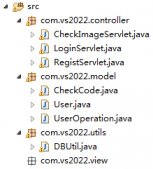一、用到的实体类如下:
Student.java
|
1
2
3
4
5
6
7
8
9
10
11
12
13
14
15
16
17
18
19
20
21
22
23
24
25
26
27
28
29
30
31
32
33
34
35
36
37
38
39
|
package com.company.entity; import java.io.Serializable; import java.util.Date; public class Student implements Serializable{ private static final long serialVersionUID = 1L; private int id; private String name; private Date birth; private Group group; public Group getGroup() { return group; } public void setGroup(Group group) { this.group = group; } public int getId() { return id; } public void setId(int id) { this.id = id; } public String getName() { return name; } public void setName(String name) { this.name = name; } public Date getBirth() { return birth; } public void setBirth(Date birth) { this.birth = birth; } @Overridepublic String toString() { return "Student [birth=" + birth + ", group=" + group + ", id=" + id + ", name=" + name + "]"; } } |
Group.Java
|
1
2
3
4
5
6
7
8
9
10
11
12
13
14
15
16
17
18
19
20
21
22
23
24
25
26
27
28
29
30
31
32
33
34
35
36
37
|
package com.company.entity; import java.util.List; public class Group { private int id; private String name; private String position; private List<Student> students; public List<Student> getStudents() { return students; } public void setStudents(List<Student> students) { this.students = students; } public int getId() { return id; } public void setId(int id) { this.id = id; } public String getName() { return name; } public void setName(String name) { this.name = name; } public String getPosition() { return position; } public void setPosition(String position) { this.position = position; } @Overridepublic String toString() { return "Group [id=" + id + ", name=" + name + ", position=" + position + "]"; } } |
二、实体对应的表结构
student表:
|
1
2
3
4
5
|
create table student(id int primary key,name varchar(20),birth date,group_id int references g_group(g_id)); |
g_group表:
|
1
2
3
4
|
create table g_group(g_id int primary key,g_name varchar(20),g_position varchar(30)); |
sequence:
|
1
2
|
create sequence student_id_sequence;create sequence group_id_sequence; |
三、Student和Group的映射文件如下,你可以在映射文件中找到,关于MyBatis的增删改查操作,MyBatis调用存储过程,MyBatis分页以及MyBatis对一对一、多对多的处理
xml文件中都标有注释,看的时候配合下面的具体实现看,虽然有点乱
student.xml
|
1
2
3
4
5
6
7
8
9
10
11
12
13
14
15
16
17
18
19
20
21
22
23
24
25
26
27
28
29
30
31
32
33
34
35
36
37
38
39
40
41
42
43
44
45
46
47
48
49
50
51
52
53
54
55
56
57
58
59
60
61
62
63
64
65
66
67
68
69
70
71
72
73
74
75
76
77
78
79
80
81
|
<?xml version="1.0" encoding="UTF-8" ?> <!DOCTYPE mapper PUBLIC "-//mybatis.org//DTD Mapper 3.0//EN""http://mybatis.org/dtd/mybatis-3-mapper.dtd"> <mapper namespace="com.company.dao.IStudentDAO"> <!-- mybatis缓存 --> <cache eviction="LRU" flushInterval="600000" size="1024" readOnly="false" /> <!-- sql标签用来定义一些可以被重用的sql语句或字段或片段等 --> <sql id="studentColumns">select id,name,birth from student</sql> <!-- 此处获得多对一的关系 ,但就单条记录而言却是一对一的关系,所以一对一的写法跟此相同--> <resultMap type="Student" id="getStudentAndGroup" > <id column="id" property="id"/> <result column="name" property="name"/> <result column="birth" property="birth"/> <association property="group" column="group_id" javaType="Group"> <id column="g_id" property="id"/> <result column="g_name" property="name"/> <result column="g_position" property="position"/> </association> </resultMap> <select id="many2one" resultMap="getStudentAndGroup" parameterType="int" > select s.id,s.name,s.birth,s.group_id,g.g_id,g.g_name,g.g_position from student s left join g_group g on s.group_id = g.g_id where s.id = #{id} </select> <!-- 意图是获得一个学生,并且获得该学生所属的组,跟上面的意思差不多 ,用association的select属性--> <!-- 于上面的相比个人感觉上面的效率要高些,因为上面只有一条sql语句 --> <resultMap type="Student" id="getStudentAndGroupUseSelectMap"> <id column="id" property="id"/> <result column="name" property="name"/> <result column="birth" property="birth"/> <association property="group" column="group_id" javaType="Group" select="selectGroup" /> </resultMap> <select id="getStudentAndGroupUseSelect" resultMap="getStudentAndGroupUseSelectMap" parameterType="int"> select * from student where id = #{id} </select> <select id="selectGroup" resultType="Group" parameterType="int" flushCache="false" useCache="true"><!-- 此处实用缓存 --> select g_id as id, g_name as name, g_position as position from g_group where g_id = #{id} </select> <!-- 动态sql语句 的测试dynamic sql--> <select id="getStudentBySomeCondition" parameterType="Student" resultType="Student"> select * from student <where> <if test="id != null"> id>2</if> <if test="name != null"> and name like '%g%'</if> </where> </select> <!-- MyBatis调用存储过程 --> <resultMap type="Student" id="studentMap"> <id column="id" property="id"/> <result column="name" property="name"/> <result column="birth" property="birth"/> </resultMap> <select id="getAllUser" statementType="CALLABLE" > {call get_all_student(#{students ,mode=OUT, jdbcType=CURSOR, javaType=ResultSet, resultMap=studentMap} )} </select> <!-- MyBatis向student表中插入一条数据 --> <insert id="add" parameterType="Student" keyColumn="id"> <selectKey keyProperty="id" order="BEFORE" resultType="int"> select stu_id_sequence.nextval from dual </selectKey> insert into student(id,name,birth) values(#{id},#{name},#{birth}) </insert> <!-- 根据id获得学生的信息 --> <select id="getById" parameterType="int" resultType="Student"> <include refid="studentColumns"/> where id=#{id} </select> <!-- 此处的实现方法是一个分页的原型,请查看IStudentDAOImpl.java中的调用方法 --> <select id="getAllStudent" resultMap="studentMap"> <include refid="studentColumns"/> order by id<!--此处是引用了上面预定义好的sql语句--> </select> </mapper> |
以上所述是小编给大家介绍的MyBatis存储过程、MyBatis分页、MyBatis一对多增删改查操作,希望对大家有所帮助,如果大家有任何疑问请给我留言,小编会及时回复大家的。在此也非常感谢大家对服务器之家网站的支持!
原文链接:http://blog.csdn.net/bestlove12345/article/details/53258345













